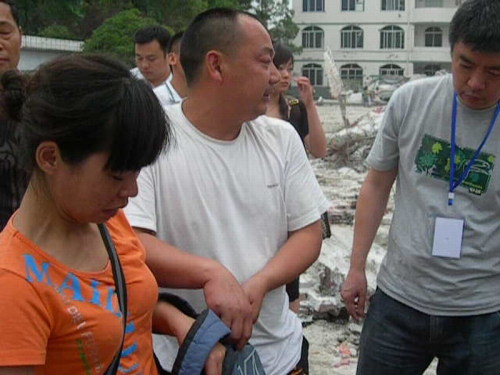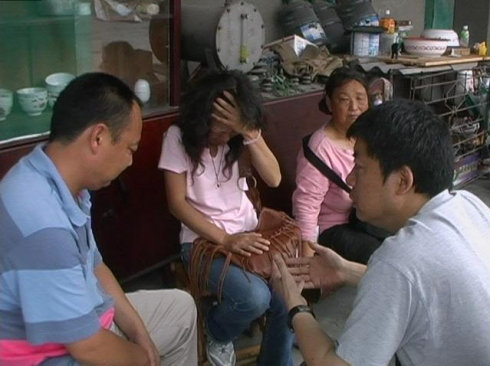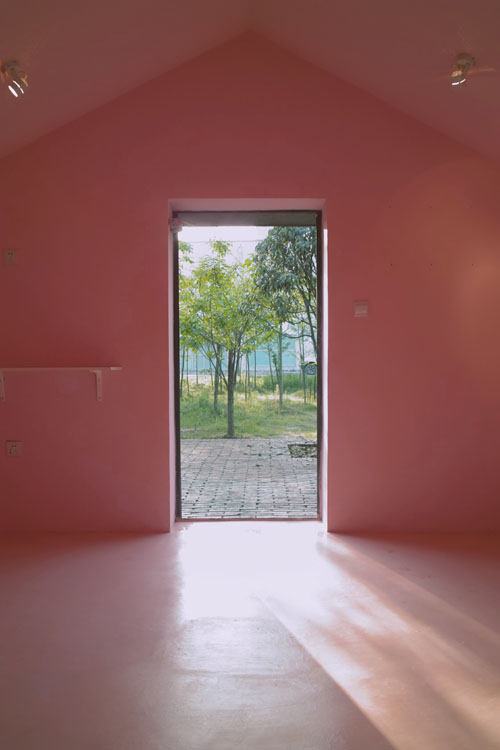Sichuan architect Liu Jiakun has constructed a memorial for Hu Huishan, a 15-year-old student who died in the May 12, 2008 Sichuan earthquake. Details on Liu’s decision to erect the memorial hall from China Daily:
Liu got to know about Hu three days after her death. He was then volunteering his services at the Juyuan Middle School, where parents claim shoddy construction was mainly to blame for the death of about 900 students. The school became a mass of debris, through which rescue machines plowed, as scores of miserable parents stood by clutching their child’s photo in their hands.
That’s when the architect saw Liu Li, Hu’s mother. The 40-year-old laid-off worker, dressed in black, was holding a plastic bag, in which she had preserved the girl’s umbilical cord and baby teeth. Incoherently, she recalled her daughter. “We love her deeply,” she said, choking on her tears. Her husband, Hu Ming, 43, wore no expression but kept mumbling, “so many kids have gone.”
Liu tried to comfort them by offering them money, but was turned down by the proud father, a taxi driver. They exchanged telephone numbers, and for a long time, the couple were haunted by Liu’s memories.
“I am a father of an 8 year old. I can hardly imagine what it would be like to see my son under that rubble. I really wanted to do something for the family,” he says.
He considered convincing them to take money so that Liu Li could have her asthma cured. Finally, he came up with the idea of building a memorial for Hu Huishan.
The memorial hall has been complete for over 6 months, but due to intervention by authorities, it is not open to the public. A forwarded message from Liu Jiakun has been spreading on the Internet. The introduction has been translated by CDT, and the forwarded letter has been translated by Lin Fanyu and edited for clarity. Photos provided by Iwan Baan and Liu Jiakun’s studio:
Architectural piece: Hu Huishan Memorial
The small memorial hall designed and contributed by Liu Jiakun was not for the state, nor the nation, nor the regime, nor a great figure. Nor was it created as an educational site to uphold nationalism or heroism. It was erected to remember a life lost in the 5.12 earthquake, an ordinary but priceless life — that of Hu Huishan, a 3rd year student in class one at Juyuan Middle School in Juyuan Township, Dujiangyan, Sichuan.
Its appeal to social meaning is very clear, but is not understood by current authorities. “Treasuring the value of ordinary lives will be the foundation of our nation’s revival.” Its design concepts are very direct and strong: a temporary shelter for disaster victims, a dwelling for the spirit of the deceased and a place to put belongings frozen “forever” in time. The atmosphere in this space is moving and profound. Located in a secluded nook, the home is greenish gray, simple. It’s a cold shell that protects a pink, vibrant, soft, and beautiful interior. In my opinion, this small building may be no Bird’s Nest or CCTV [tower], but its architect has given us this era’s most powerful question and response.
In reality, what’s most amazing is that this kind of small building is exceptionally low-key, having withstood a great and nameless “pressure.” It was quietly constructed and could not go public in order to avoid premature bad luck. The project finally finished on the 5.12 earthquake’s 1 year anniversary. Friends concerned with the memorial hall let out a sigh, and all wished to visit [Hu Huishan]. Suddenly, people received word of even more unbelievable news: the “relevant authorities” were informed about the memorial hall and would not allow it to open to the public!
Now, we must do our utmost, widely disseminate news of Hu Huishan’s Memorial to the public, seek approval from society’s enlightened people, get the media’s support, and fight for the early opening of this memorial.
Below is Liu Jiakun’s forwarded article. Feel free to pass this on to your friends:
Hu Huishan Memorial 胡慧姗纪念馆
Liu Jiakun 刘家琨胡慧姗,女,四川省都江堰聚源镇聚源中学初三一班学生,生于1992年10月11日,埋于2008年5月12日下午2:28分汶川地震,卒时不详。享年15岁,火化时间2008年5月15日。生前喜欢文学,梦想成为作家。
Hu Huishan, female, grade 9, class one student at Juyuan Middle School, Juyuan Town, Dujiangyan city, Sichuan. She was born on October 11, 1992. On May 12, 2008 she was buried in the Wenchuan earthquake that occurred at 2:28 pm. Her exact time of death remains unclear. Her life spanned 15 years, and her cremation took place on May 15, 2008. She enjoyed literature, and dreamed of becoming a writer.
父亲:胡明,都江堰青城纸厂下岗工人,43岁。
Father: Hu Ming, laid-off worker of Qingcheng Paper mill, Dujiangyan, aged 43.
母亲:刘莉,都江堰青城纸厂下岗工人,40岁。
Mother: Liu Li, laid-off worker of Qingcheng Paper mill, Dujiangyan, aged 40.女儿临终那天早七点留给我的临终遗言是:‘妈妈昨天是母亲节我忘了送花给你还有妈妈我忘了拿牛奶了你请大伯给我带来。’ 她去世在她爸爸过四十三岁生日后第三天临终前身上过敏在发红疹很痒女儿啊!妈妈对不起你啊!她去世在我和她爸爸的结婚纪念日第十一天母亲节的第二天
————-摘自刘莉手机纪事
My daughter’s last words to me at 7 o’clock in the morning were, “Mum, yesterday was Mother’s Day, but I forgot to send you flowers. Also, I forgot to take the milk. Could you ask my uncle to bring it to me?” My daughter left the world three days after her father’s birthday, two days after Mother’s Day, and 11 days after her father’s and my wedding anniversary. In her last days, she was suffering from allergies and itchy red measles. I am so sorry, daughter!
(Extracted from Liu Li’s mobile record)
5月15日第一次去聚源中学。我似乎看见过胡明刘莉,但我不确定,因为我自己处于震骇状态中。5月28日再去现场,还有父母在哭诉祭奠,其中甚至还有双胞胎女儿都埋在废墟里的母亲。现在回想起来,我觉得是刘莉珍藏的女儿的脐带乳牙那份细微具体和胡明的坚强骄傲紧紧抓住了我。我们谈了很久,准确地说是我听了很久,因为我实在没有什么可说的。在这次地震中,悲痛最深的是什么人?我想就是失去儿女的父母。临走时,我对刘莉说:“再生一个女儿,还是叫胡慧姗。” “对!”刘莉眼睛一亮,“我就是这样想的。”这句话成了我和他们两口子之间的一个默契。我决定要长期帮助他们,直到他们进入新的生活。我不晓得我能帮些什么,我记下了他们的联系方式,也记住了刘莉的哮喘不轻。
On the 15th of May, I paid my first visit to Juyuan Middle School. I think I met Hu Ming and Liu Li then; however, I am not certain, for at the time, I was in a state of shock. I returned on the 28th of May, still finding other parents mourning their losses, including a mother who had both of her twin daughters buried in the ruins. As I recall now, it was Liu Li’s detailed thoughtfulness in keeping her daughter’s umbilical cord and deciduous tooth, as well as Hu Ming’s toughness and pride that moved me. We talked for a long time — or to be more precise, I listened for a long time, because there was nothing else, as a matter of fact, that I could say. It makes me wonder, who are the ones that bear the deepest sorrow in this earthquake? I think it must be those parents who have lost their children. Upon departure, I spoke to Liu Li, “Give birth to another baby girl and name her Hu Huishan.” “Right!” her eyes suddenly sparkled with hope, “that is exactly what I was thinking.” Through these words, the couple and I arrived at a mutual understanding. I decided to offer them long-term help until they embarked on their new life. I didn’t know how I could help them, so I jotted down their contact information. I also noticed Liu Li had serious asthma.
第二天我给胡明打过电话,请他帮我收一下满地的学生书包。中间有好多天我没有联系,是因为看了心理干预的电视节目,我有点犹豫担心:是不是该去?会不会触碰伤口?
On the next day, I made a phone call to Hu Ming and asked him to help me collect the schoolbags scattered on the ground. After that, I stopped contacting them for a few days. It might be the effect from those psycho-interference programs on TV that led to my hesitation. I asked myself if my going would inflict wounds on their hearts.
6月21日,我再到聚源。一是想取书包,二是想商量带刘莉去看病的事。我赫然发现他们住在救灾帐篷里。不光是女儿,他们的房子也塌了,身边还有一个残疾老母亲。书包找不到了,帐篷区很乱。我原来想当然地认为是收在他家里的。胡明有点内疚,我赶紧岔开这个话题。东拉西扯中,我觉得先前的担心是多余的。他们痛失至爱,希望破灭,他们仍然迫切需要有人倾听。倾听即是安慰。
I went back to Juyuan on the 21st of June with a few things in mind. First, I wanted to collect the schoolbags, and besides that, I wanted to speak with them about getting Liu Li to see a doctor. To my astonishment, I found them living in a makeshift tent. In the disaster, they lost not only their daughter, but also their house. Together with them was their surviving but disabled old mother. The schoolbags were nowhere to be found, for the tent area was almost a mess. At the beginning, I took it for granted that he would have kept the collected schoolbags at his home. Hu Ming felt a bit guilty about this, so I quickly turned away from this topic. In our random conversations, I came to realize that my worries were totally useless. They have lost their precious child and their hope, but they were still in need of someone to listen to them deeply, as listening itself brings consolation.
我吞吞吐吐说出这些天来萦绕于心的想法:为他们的女儿建一个小小的纪念馆。接下来的事我始料未及。打算做一点力所能及的事就得到如此感激,足以使我重省人生意义。我一直自愧能力不足,做不成更多的实事,我一直有点怀疑我这个想法在目前的生存现实下也许太过诗情画意,也许对他们不是实际帮助,而胡明的话使我不再怀疑。那些实际的物质困难,“都是身外之物”,对心灵的安慰才是最深切的安慰。那么好吧,想到啥就做啥,做一点是一点。
I muttered the idea that had been lingering in my mind for days: to build a small memorial for their daughter. And what followed surpassed my expectations. Their sincere gratitude for my tiny effort made me reconsider the meaning of life. Up till then, I was ashamed of my lack of ability that does not allow me to achieve much that is practical. And until then, I suspected my idea might be too poetic given their current situation, and that it would not equate to any practical help for them. But Hu Ming’s words cleared my doubts. Physical sufferings are all “worldly possessions”, and the most heartfelt consolation must come from the healing of the soul. If so, then, we can only go with our heart, and give whatever we can provide.
胡慧姗纪念馆以灾区最为常见的坡顶救灾帐篷作为原型,采用框架结构及再生砖建造,表面施以乡村最常见的抹灰,像灾区常见的一样,室内外均采用红砖铺地。单纯,朴素,普通。一个田边林间的小小的纯粹空间。虽然小,但足以勾起人们对地震的集体记忆;虽然小,但却是我设计生涯中最有意义的事情。
The Hu Huishan memorial takes its model from the pitched roof makeshift tents frequently used in quake-stricken areas. It was built with column and beam framed construction and rebirth bricks. The surfaces are plastered in a way similar to that in local countryside houses. The floor in the exterior and interior is paved with red bricks, just as those commonly seen in the houses at quake-stricken areas. The goal is to achieve a sense of simplicity, austerity and universality. A pure space placed among the trees and the open field. Though small, it is enough to remind people of the collective memory of the earthquake. Though small, it is the most meaningful work I have done in my whole architectural career.
室内两侧墙上陈列胡慧姗短促一生中留下的少许纪念品:照片,书包,笔记本,乳牙,脐带……她的一生没来得及给社会留下多少痕迹,她不是名人,她是个普通女孩,是父母的心肝。
Inside the memorial, the sidewalls display a few remembrances which record Hu Huishan’s short life: photos, schoolbag, notebooks, deciduous tooth, umbilical cord… Her life didn’t leave many traces in society. She is not a celebrity, only a normal girl – a pearl in her parents’ eyes.
尽端墙上有一面屏幕,放映我在聚源结识她父母后拍下的一系列视频。这小小的空间可以供几个人坐下观看,因此它实际上有点像一个家庭放映厅。这里的内容没有悲壮热烈和宏大喧嚣,只是关于一个花季少女的追忆,以及一个悲伤绝望的家庭如何奋力继续生活。
A screen is set on the wall of the far end, displaying a series of videos recorded in Juyuan after I met her parents. This small space can accommodate a few people to sit and view the screen, thus functioning much like a small family projection room. It displays nothing solemn or loud, but something in memory of a flowery age maiden, and something about how a despaired family strives to live on.
我不知道我想出资修建的这个小小纪念馆是不是世界上最小的纪念馆。这个纪念馆,是为他们的女儿,也是为所有的普通生命——-对普通生命的珍视是民族复兴的基础。
I don’t know whether this memorial, which I donated and built, is the smallest one in the world. But this memorial is built for their daughter, and is also built for all the ordinary lives. Treasuring the value of ordinary lives will be the foundation of our nation’s revival.
2008-6-30
地点(Location):中国 四川大邑安仁 Dayi town,Dayi county, Sichuan Province, P.R.C
项目团队(Project Team):建筑师(Architects):刘家琨、罗明,孙恩,张瞳/ Liu Jiakun,Luo Ming,Sun En,Zhang Tong
结构工程(Structural Engineering):刘速 Liu Su
建造时间(Construction Period):2009.3~2009.5
基地面积(Site Area): 58m²
建筑面积(Building area):19 m²
业主(Owner):家琨建筑工作室捐建 donated and constructed by Jiakun Architects
用途(Use):纪念馆 Memorial项目概念和描述(Project Concept and description)
胡慧珊纪念馆位于安仁建川博物馆聚落“512地震馆”旁的一片小树林中,是为在512地震中死难的都江堰聚源中学普通女生胡慧珊而建。纪念馆采用救灾帐篷为原型,面积,体量,形态均近似于帐篷,外部红砖铺地,墙面采用民间最常用的抹灰砂浆,内部为女孩生前喜欢的粉红色,墙上布满女孩短促一生的遗物。从一个圆形天窗撒进的光线,使这个小小空间纯洁而娇艳——–这个纪念馆,是为一个普通的女孩,也是为所有的普通生命——-对普通生命的珍视是民族复兴的基础。
Hu Huishan Memorial House located in a piece of forest next to the “512 Exhibition Hall” of Jianchuan Museum Cluster, Anren. This memorial is built for Hu Huishan, an ordinary female student from Juyuan Middle School who was buried in the Wenchuan earthquake. The memorial takes its model from makeshift tents. The floor in the exterior is paved with red bricks, and the surfaces is plastered in a way that is done in the local countryside houses. The interior wall is painted into pink which is the girl’s favorite color and full of remembrances , which recorded her short life. A ray of light from a round clerestory, makes this small space pure and charming —— this memorial is built for an ordinary girl, and is also built for all the ordinary lives —— Treasuring the value of ordinary lives will be the foundation of our nation’s revival….(林凡榆翻译)(图片1,3-9摄影者为Iwan Baan,其余为家琨工作室提供)























